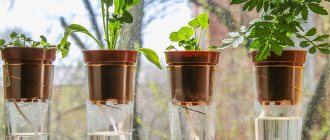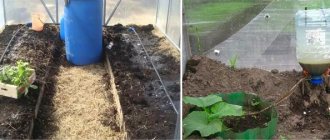Proper watering of Saintpaulias is a prerequisite for their cultivation. Each violet lover uses trial and error to select the optimal method of irrigating plants. Among experienced gardeners, wick watering of violets is very popular. It reduces the time required to care for a large collection of flowers, takes into account the individual watering needs of plants, and allows you to leave home for a while, for example, to go on vacation.
Using watering through a wick, plants are automatically irrigated without requiring constant human presence. To equip it, you do not need to install a complex system or purchase devices and mechanisms.
The essence of the method of watering violets using the wick method
Wick watering is a method that makes the life of gardeners much easier, since these plants do not really like top watering. Using the traditional method, you can flood the flower, and water will get on the leaves, and violets absolutely cannot tolerate this. Therefore, wick watering is ideal for them. Its essence lies in the fact that with the help of a special wick or cord that extends from the soil at the bottom of the pot, the plants immediately receive moisture from the vessel below. This way they can take only the amount of water they need.
Violets on wicks
Advantages and disadvantages of the method
Amateur flower growers who have used wick irrigation for violets express conflicting opinions about the advisability of its use. This is due to the fact that the method has not only advantages, but also disadvantages. Its undeniable advantages:
When planting violets on a wick, small pots are used, so the volume of soil mixture is reduced, and flowerware is cheaper.
Knowing the vulnerable points of watering plants through a wick will help reduce its possible negative consequences. The disadvantages of wick watering violets are as follows:
Converting indoor plants to wick watering may entail re-equipping flower shelves, since they must accommodate not only pots, but also containers underneath them.
Pros and cons of converting Saintpaulias to wick irrigation
Advantages of transferring violets to wick watering:
- Providing better conditions for the growth and development of violets - flowering will begin earlier and last longer.
- No need for individual watering.
- If you choose the right proportions of water and fertilizer, there will be no oversaturation or lack of necessary substances.
- The florist can not worry about the condition of the Saintpaulias for quite a long time and can calmly go on vacation.
- The plant cannot be overwatered, since it will take the required amount of water on its own.
- Mini and micro violets grow well only on a wick.
- The smaller the diameter of the pot, the more intensively the violet develops.
DIY drip irrigation for indoor plants
Reasons why you should not switch plants to wick watering:
- If the wick is incorrectly selected, the root system may become oversaturated with moisture, causing the roots to rot.
- With this method of watering, leaf rosettes become larger and therefore take up more space.
- In winter, it is better not to keep violets watered in this way on the windowsill, as the water may become supercooled.
Important! This method has much fewer disadvantages than advantages. Even if you give up wick watering for a while, for example, in the cold season, you can always switch your violets to it again.
Which wick is best for violets?
Many gardeners who grow violets use the usual method of watering these indoor plants. Some people moisten the soil, while others pour water into the pan. As a result, the problem of drying out or waterlogging of the earthen clod often arises, which does not have the best effect on the plant. The only effective solution to this problem is wick watering of violets. This type of cultivation is very convenient and allows you to create optimal growing conditions for flowers. 1. Wick irrigation technology Unique wick irrigation is based on the use of a regular cord: water from the container rises up the wick, giving moisture to the ground. As a result, the violet receives the required amount of moisture, without the risk of waterlogging. Depending on the time of year and the level of air humidity, the flower will use water in different volumes.
Wick watering for violets has some features:
2. How to change the watering system to wick when propagating violets? Converting this indoor plant to wick watering is quite simple. To root leaves with petioles in sphagnum using wick irrigation, you will need: a small plastic cup, live sphagnum moss, a wick and a complex fertilizer, for example, Nutrisol. Auxiliary tools will be scissors and a blade, an awl or wire, a felt-tip pen and sticks.
The first step is to make a hole in the cup through which you can pass the wick. To do this, you can use a heated awl or wire. You can also make a hole with a knife.
In order not to confuse the varieties of violets, their names are written with a felt-tip pen on the cup. Some people use adhesive price tags that they sign with a pen and stick on the cup, or sticks that they use to stir the coffee. They can then be stuck into the ground.
The moss is crushed into small pieces of 3-5 cm, which will make it easier to separate the children with roots from the sphagnum in the future. Very often the moss begins to sprout, forming a green mass. This is a completely natural process that prevents rotting of the planting material. After all, sphagnum has strong bactericidal properties. In some cases, it is necessary to remove its excess so that in the future it does not interfere with the separation of babies. Next, prepare the container for planting. We pull the wick filter through the hole so that a ring of cord is formed inside the pot. The rest of the material should remain outside. Place a 3-centimeter layer of moss on top of the ring, compacting it slightly. We make cuts on each cutting using a sharp knife or blade, leaving the length of the cutting 2-3 cm. Some gardeners do not cut, but simply break off the cutting, which will also be correct. For those who are starting to grow violets and are afraid of the cuttings rotting, it is recommended to make smaller cuts. But it is worth remembering that for ease of rooting, the cuts need to be made higher. Prepared planting material can be dipped into the preparation Kornevin, which accelerates the process of the emergence of a root system in the plant.
For the planted leaves, make a support from coffee stirring sticks or any other suitable material. It is not recommended to use wooden sticks, as this may cause rotting of the leaf plate. The cuttings are planted in cups separately. If one specimen becomes infected with diseases, the others will be protected. If the leaves are large and do not fit in the cup, they can be safely cut off along the edges parallel to the walls of the container. It is advisable to treat the sections with charcoal powder.
After planting, the cups are placed on a container with Nutrisol solution so that the wicks become completely wet and provide moisture to the moss. This is one of the first and main conditions for the successful operation of an irrigation system using a wick. After this procedure, the cups are placed on a container intended for wick watering.
After 2 weeks, you can observe the revival of the leaves - they seem to have risen above the glass. You can pull them slightly to feel resistance. This indicates that everything is going well, and the cuttings have put down their first roots. In order to speed up the birth process, you need to use additional lighting. The period for the appearance of children depends on the variety and conditions of violets, and on average ranges from 1 to 3 months.
If during this time the babies have not appeared, stimulation is carried out. To do this, the leaves are cut one third from the top. If the leaves are large, cut them in half.
For successful and full growth, violets need to be provided with the correct temperature within 20-22 degrees. Some gardeners practice transplanting cuttings immediately after the first roots appear. You can also wait for the babies to appear and then perform a transplant. As soon as the babies reach 1/3 the size of the mother leaf, they can be safely separated and replanted. By the way, you can leave the rooted cutting; after a while it will give another generation of young plants.
3.How to prepare for the transition to wick irrigation? If you have been growing violets for a long time, wick watering can be organized at any stage, and the principles of the transition are as follows: 1) Correct selection of soil mixture for planting. It is prohibited to add soil to the mixture, since soil can attract moisture. In the future, this will lead to rotting of the roots. A mixture of vermiculite, peat and perlite in equal parts is best. Using coco peat mixed with perlite will be equally effective. Such a composition, which does not include soil, will be porous and will ensure the active formation of roots in the flower. Coco peat is washed before use because it is rich in salts. Such a loose mixture, which does not contain soil, is air- and moisture-permeable and ensures uniform development of the root system. 2) We stretch the wick through the hole, forming a ring at the bottom of the pot, then fill the pot with substrate and plant the young plant there. The important thing is that wick irrigation does not require drainage. Even the smallest specimens take root quite successfully in such a mixture. 3) In order to ensure uniform impregnation, flowerpots with flowers are placed on a large tray or tray with water. Some spill flowers from above, covering the leaves of the plants. If necessary, add more substrate. Here it is very important not to sprinkle the growing point, so as not to ruin the young plant. Then the pot is placed on a container for wick watering, adding the solution. 4) Since such soil does not contain nutritional components, young plants need to be fed periodically. Fertilizer is applied through a wick. Nutrisol 0.05% concentration is perfect as a feed for violets.
The wick ensures a uniform supply and distribution of nutrients, which reduces the risk of excess or deficiency for plants. At the same time, it is very important to monitor the condition of the violet. If the plant grows successfully, then everything was done correctly. If the leaves of a flower begin to turn yellow and fall off, the concentration of the fertilizer is increased. A reddish or white coating formed inside the rosette indicates the need to reduce the concentration of fertilizing.
If the wick system has stopped working due to untimely application of the solution or the wick has simply dried out, this is not a problem. In this situation, the substrate is simply spilled or placed in a container with a solution or water so that it is saturated again.
Violets grown in the ground can be easily transferred to wick watering. To do this, carefully remove the plants from the pot, shake off the soil from the roots and plant them in a new pot under wick watering. In just a few days, the plants will come to life again and will delight you with their beautiful and healthy appearance.
Wick watering is a really convenient method that many gardeners use. In order not to damage or destroy all the plants, you should conduct an experiment - transfer only a few low-value specimens to wick watering and observe their condition for a month.
Source
Found a mistake? Report it: 1) Select the error with the mouse 2) Press CTRL+Enter. Read more.
So I also read that if you wet a cord, let it dry, and then put it in a glass of water, and if it immediately gets wet, it’s good for a wick; if it remains floating on the surface without being wetted by water, look for another one. As a result, the acrylic sank, and the polyester got wet, but floated.
Now I doubt which one is better to use. Help me please.
Wick watering of violets: how to do it - preparation
Automatic watering for indoor plants - do it yourself
To organize proper wick watering for violets, you will need: properly prepared soil, a pot, a water container and the wick itself.
Soil preparation
When using wick irrigation, you will need loose, moisture- and breathable soil. In addition to peat, its composition must include a leavening agent - sand, perlite, moss. A good layer of drainage located under the soil layer is also necessary.
Composition of soil for violets
Important! Before planting, it is better to disinfect any type of soil with a manganese solution or special disinfectants.
Selection of containers
The flower pot should be small, but not too cramped. It is better if it is plastic - this is the lightest material that will not add weight that puts pressure on the container for watering. The container itself can be one for several pots or individual for each violet.
Advice! It is better to use large tanks, since it is easier and faster to add water and fertilizers to them.
One container for several flowers
What to make a wick for violets from
It is most convenient to use a synthetic cord as a wick, since natural fabrics will quickly rot. The selected material must absorb water well. The thickness of the wick varies and is selected individually for each pot. As a rule, a cord 5 mm thick is selected for a pot with a diameter of 5-8 cm.
Fertilizers used
Any fertilizer suitable for violets can be used. Let's look at some of them:
- Agrecol NPK 9:4:5 - during growth;
- Agrecol NPK 4:5:8 - when buds appear and flower;
- solution concentration - 0.5 ml per liter of water;
- Fertika - solution concentration: 100 g pack per 2.5 liters of water. Add to the solution during wick watering at the rate of 1 tsp. per 1 liter of solution;
- Kemira Combi - 2% concentrated solution: 20 g pack per 1 liter of water. To obtain a 0.05% solution used for wick irrigation: 5 tsp. (25 ml) per 1 liter of water.
If the plant is constantly on a solution containing fertilizer, then the concentration of the solution should be 3-4 times less than indicated in the instructions.
Growing and caring for verbena in your garden.
See photos of gatsanii flowers on our website: https://rusfermer.net/sad/tsvetochnyj-sad/vyrashhivanie-tsvetov/posadka-gatsanii-yuzhnoafrikanskoj-romashki-v-nashih-shirotah.html
How to transfer violets to wick watering: step-by-step instructions
DIY drainage for indoor plants
Obviously, wick watering for Saintpaulia is preferable to conventional watering. But you need to transfer to it, following certain rules, so as not to harm fragile plants.
Mature plants
Adult flowers can be easily transferred to wick watering. To do this you need:
- Prepare all the necessary components to carry out the process.
- Pour the previously prepared soil mixture into the pot, replant the violet using the transfer method, and pour water so that the soil becomes wet and settles.
- Drain off any remaining water that has not been absorbed and place the pot on a container with prepared warm water.
- The distance between the pot and the liquid level should be 1-2 cm.
Now the violets will not need top watering; they will receive water through the wick. Therefore, you don’t have to worry about water getting on the leaves, sunburn and overflow of flowers. By experimenting with different types of containers, you can find an option that is more convenient and beautiful.
Preparation of materials for wick irrigation
Sockets
- Prepare the necessary materials that will be used in the process of bottom watering.
- Check for a hole in the flower pot.
- Prepare the wick. For one pot you will need a cut about 20 cm long, one end of which is placed in a spiral on the bottom of the pot, and the second is placed in a vessel with water.
- A layer of sphagnum is laid on a circle laid in a spiral, which will further contribute to the potential separation of the children. A layer of prepared substrate is poured on top of the moss.
- Violet cuttings are planted. Each cutting is placed in a separate container.
- In order for young plants to be saturated with moisture, the pot must be completely immersed in a solution with a growth stimulator.
- The glasses are placed on vessels with water so that they are a couple of centimeters above the liquid level.
If everything is done correctly, the cuttings will take root in a few days. Evidence of this will be the green leaves rising up.
What does an organization need?
Wick irrigation technology uses the ability of the cord to absorb liquid from the container and saturate the soil in the flower pot with it. Plants receive the amount of moisture they need without the threat of soil waterlogging.
Wick requirements
The material used to make your own wick is a synthetic fiber cord. Natural fibers and fabrics are not used, as they rot quite quickly.
The optimal cord thickness is from 1.5 to 5 mm, length is from 15 to 20 cm.
To ensure that the chosen material is suitable for making a wick, it should be moistened with water, allowed to dry and placed back into the liquid. If the cord immediately gets wet, you can safely use it to make a wick. If it does not get wet and floats on the surface of the water, then the material is not suitable.
Before laying in the pot, the cord is pre-moistened with water.
What should the soil be like?
To set up an irrigation system through a synthetic wick, a properly selected soil mixture is of great importance. It should be breathable, light, loose. To do this, equal parts of vermiculite, peat soil and coarse perlite are added to the soil for wick irrigation.
Before mixing, perlite and vermiculite are moistened with water until slightly damp, but not wet. The resulting soil is not nutritious enough, so for lush, long-lasting flowering of the rosettes you will need high-quality fertilizing.
Selection of capacity
A flower pot is selected with a small diameter: from 7 to 11 cm. If the holes at the bottom of the container are too large and the substrate spills out through them, they are covered with a piece of synthetic fabric. No need to use clay pots. It is recommended to choose light containers, since the design is quite heavy.
As containers for water, you can purchase ready-made dishes specially designed for irrigation through a wick, or use plastic food containers. For example, 500 ml plastic disposable cups are suitable for pots with a diameter of 9 cm.
If a food-grade plastic container is used instead of a liquid reservoir, pour water into it, close it with a lid, and cut a hole in it for the cord. The pot of Saintpaulia is placed on top, the string is threaded through the hole in the lid, and then lowered into the water.
When using disposable plastic cups, lids are not needed. They are tightly covered with pots, and the solution does not evaporate. The distance between the bottom of the pot and the liquid in the glass should exceed 0.5 cm.
How often to add water to the container so as not to flood the violets
Water is added to the container as it is consumed. The lace must be constantly in the water. It is best not to allow the liquid level to drop more than 2 cm from the bottom of the pot.
In hot summer you will have to add water more often than in autumn or spring. In winter, it all depends on where the flowers will be located. If they stand next to a central heating radiator, you will have to monitor the moisture level.
Important! During a long vacation, it is worth adjusting the length of the wick, since violets do not like dry soil.
Wick watering of violets is a system that you should not be afraid of. Plants watered in this way grow faster, bloom more luxuriantly and last longer. For Saintpaulias, this type of watering is most useful, since they can consume exactly the amount of moisture and nutrients that they need. As a result, there is no need to worry about either overfilling or underfilling. The composition of the liquid in the container can be adjusted by checking the reaction of flowers to different types of fertilizers.
How to prepare a pot for reuse
If the owners have a large collection, it is expensive to buy new containers every time. Even when they use cheap plastic.
Old pot:
- Free from substrate and drainage residues.
- Soak for 2 hours in hot soapy water.
- Remove deposited salts with steel wool or a stiff brush.
- Pour in a sterilizing solution overnight. For example, dilute 100 ml of bleach in 2 liters of liquid.
- Rinse thoroughly with clean water.
The same is done with trays or tanks for wick irrigation.
Preparatory stage
At the preparation stage, you need to stock up on a pot, filler and wick.
Potty requirements
Flower growers recommend giving preference to pots and water containers that are made of plastic; the diameter of the upper rim does not exceed 8 cm. The material is easy to wash and disinfect. It is easy to make a hole of the required size in the bottom part.
Reference! Plastic cups, bottles and containers are suitable for organizing wick watering.
When placing small pots on a common tray of water, you need to place a grate on the bottom so that the containers do not touch the water.
Suitable soil
For unhindered water to rise through the wick, you need a substrate that has high breathability and the ability to retain a moist environment. The mixture for filling the pot includes:
- vermiculite;
- perlite;
- sphagnum moss;
- peat and other components.
Mixture option: one part each of perlite, vermiculite and peat. The prepared soil is poor in nutrients, so regular fertilizing should be provided.











